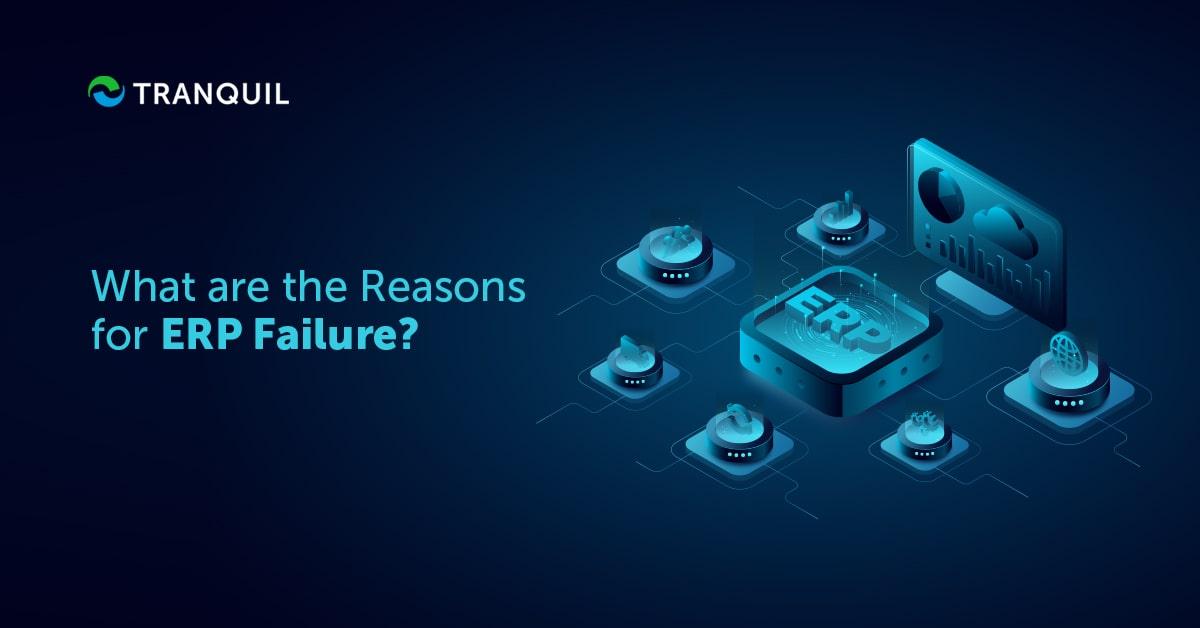
Switching over to a new system is always difficult, and often, expensive – and it’s the same for an ERP.
Unfortunately, the implementation of new software is not given the same importance as some of the fundamental business activities, and this can be problematic.
Businesses tend to ignore aspects of ERP implementation like cash flow, analyzing benefits, performance goals, risk assessment, and so on, and focus instead on minimizing expenditure related to implementation.
And then they hope for a miracle to make business operations efficient overnight.
Of course, this does not happen, and the blame then goes to the system; not to the wrong implementation of it.
In some instances, the management recognizes that it is the lack of planning that has caused the implementation to fail.
They may be forced to hire an expert ERP consultant to re-implement the solution, which is double the expense.
ALSO READ: How ERP Can Improve Business Efficiency?
Here are some of the most common reasons for failure of ERP implementation:
Businesses often underestimate the resources needed to implement ERP.
Organizations must have a realistic and precise understanding of the resources both internal and external resources, that will be needed.
The company should have a robust timeline with regard to the commitment needed from employees who will use the system, like the Finance, Accounting, or HR departments.
You may need to hire temporary resources to maintain process continuity while the users undergo training on the new system.
The business should get information from consultants, vendors, or contractors regarding external resources – the skills, resources, and duration required to successfully implement the new system.

One of the biggest ERP implementation failure reasons is a lack of understanding of organizational requirements – the purpose behind implementing the ERP should be very clear.
Make sure you sit down with all the relevant senior employees and managers and get feedback about their pain points that need resolution.
Discuss future plans and try to predict where similar issues may crop up.
Once you have all the requirements from everyone, trim the list to include the most important requirements, and also note down the features that are necessary for your ERP.
You can also note down the features that are not essential but would be valuable.
ALSO READ: Benefits of ERP in Production Planning
An ERP system is expected to be used for the long term, and therefore you need to pick out experienced employees for the implementation – those who have been through an implementation before, and who know your business goals and needs thoroughly.
When it comes to the external consultant too, make sure that they are experienced, and have performed implementations in companies of similar business or size in the past.
Customization, interfaces, and data conversion are the chief areas of technical risk in ERP implementation.
Sometimes customization can increase the cost and time needed for deploying the solution.
While some customization is often required, and possible, that over-customization can cause huge technical issues that can throw everything out of gear.
True, there is no need to implement the ERP as is if it doesn’t meet your requirements, but you shouldn’t go overboard with the customizations – they should be only performed to derive benefits for the company.
ALSO READ: How Do ERP Systems Work?

The success and failure of ERP implementation hinges to a great extent on the project management of the implementation.
The size and scope of ERP implementation necessitate a dedicated and experienced professional who can supervise the different activities of implementation.
They should be able to look at the big picture while not letting the small details slip by them.
When project managers actively participate in selecting and implementing the ERP, that is when it becomes really successful.
Make sure you choose someone who is capable of understanding the users’ pain.
The ERP system should be implemented systematically and in an orderly fashion, and the strategy should be aligned with the company’s goals.
Without a clear strategy and understanding of the problems it is expected to resolve and the expected outcomes, implementation can be pretty challenging.
A good implementation strategy should consider deadlines, budgets, financial benefits, and important business processes, and make sure they are properly taken care of.
With no clarity on the goals, the strategy could become confusing.
When ERP is deployed successfully, a business can gain a competitive edge, boost productivity and plant utilization, enhance customer service, reduce expenses, and manage inventory more efficiently.
ALSO READ: ERP Software to Enhance your Purchase Management

If the people at the top are not committed to the ERP implementation, that sentiment will trickle down to everyone in the company.
Management should allocate appropriate resources for ERP implementation, and reassign them according to changing conditions.
Money is a major resource – and if the leadership is unwilling to pay, the project can get delayed.
The same goes for people – while they need to be diverted to ERP implementation, their basic tasks also need to be done.
The management has to ensure that work continuity is maintained through temporary hires.
Since ERP is a pan-enterprise task, the top leadership must ensure that executives from every department commit to the use of all required resources.
It is vital that you have to have appropriate resources in your ERP team – skilled and experienced.
If you don’t assign the required resources, your ERP can fail.
Whether you assign your current employees or hire temporary employees for the purpose, you need to realize, that a significant amount of time is required.
When you use your own employees, you need to ensure that their regular work has to be completed as well.
One solution could be hiring outside resources to work on specific tasks like data conversion.
ALSO READ: What are the Challenges in ERP Implementation?
This is extremely important.
You need to establish who is responsible for various tasks, and at what level.
A decision that is not timely, clear, and of high quality, can cause your ERP implementation to fail.
The majority of the decisions regarding the implementation should be taken at the team level, as waiting for the top management for every little thing can cause too much delay.
After all, it is the team members who will use the system and who are familiar with the processes who are best placed to know what is wrong, and what changes can improve things.

Whatever proof you give people, the lower-level employees will resist the implementation or at least resent it.
After all, it’s a whole lot of work for them, and they won’t look forward to it.
Therefore, it’s imperative that you communicate the necessity and importance of the ERP implementation thoroughly; we recommend starting a little early so that they have the time to come to terms with it.
Resisting change is human nature, and fear it; some may be able to see the benefits and future possibilities.
Many may not understand the need to switch to a new system at all – but with a little preparation, you can get your employees to cooperate wholeheartedly, and the implementation can be successful.
You can think of hiring change management consultants to handle this situation if the resentment is very high.
ALSO READ: Modules in ERP Software
Any new system, when implemented in an organization, mandates that the users be properly trained in its use.
Those who are not well trained, will cause a drain on the resources of the implementation team and eventually, your company.
When the resources reduce, your ability to resolve problems also diminishes and the implementation may just sink.
We have already established that ERP implementation can be expensive and that the top leadership must be willing and able to allocate the necessary funds.
Remember that if your implementation fails because you did not divert the requisite funds, it will cost you a whole lot more.
Apart from the price of the software itself, you may have to pay additional hires, contractors, consultants, specialists, and so on.
You may in some cases, have to improve your infrastructure, especially if you are deploying the ERP on your premises.
System improvements, bug fixes, tech support, etc. are other areas you can expect to spend on in the future.
You will definitely save a lot, but that will happen later – the expenses will come first.
ALSO READ: Ways to Improve ERP with AI

Preparing and cleaning up data is time-consuming and can be monotonous.
You need to know how the system works, and at the same time, you need to have the correct format for the data.
It’s like the question of whether the chicken came first or the egg!
Both data cleansing and the system building have to happen simultaneously – and if not done properly, can cause your ERP implementation to fail.
We recommend that you separate your data into static and dynamic; static data is information that has to be entered only once – like vendor contact info; dynamic data is information related to transactions.
The static data resides in tables of data fields, with some being optional and some mandatory and some optional fields.
You need to then map the fields back to your legacy system, and decide how to copy data into your new system.
ALSO READ: Influence and Importance of ERP System in Different Industries
Dynamic data is also similar; however, the difference is that there will be numerous transactions pertaining to one vendor or customer, even going back years – and you don’t need to transfer it all.
Pick what you want to move – only that data that provides value.
You also need to correct any misspellings, eliminate duplicate records, and complete any incomplete information.
While this is not rocket science, it can be confusing to people who are not very tech-savvy.
At Tranquil, we can help you with data cleansing after we understand your unique requirements.
To Sum Up
Change is always difficult and time-consuming, but it is worth it if the change results in something good. You can ensure that you get good results with change if you invest sufficient time and effort, and are dedicated to making it work for you.
At Tranquil, we have the expertise of implementing ERP solutions for businesses of all sizes and across all industries. We can perform the right number of modifications and customizations, and provide guidance, or even consultants to ensure that your implementation is successful. If you are not sure how it works and how it can benefit your organization, do schedule a demo with us at a time of your convenience. Our team will walk you through the system and answer any queries you may have.